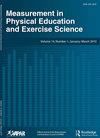Linking MIMS with ActiGraph Count: An Equating Study
IF 1.9
4区 教育学
Q2 EDUCATION & EDUCATIONAL RESEARCH
Measurement in Physical Education and Exercise Science
Pub Date : 2022-05-05
DOI:10.1080/1091367X.2022.2072688
引用次数: 0
Abstract
ABSTRACT To convert accelerometer-based devices onto the same scale, a platform called Monitor-Independent Movement Summary (MIMS) was created and used in national studies. Yet, its physical activity (PA) intensity cutoff scores have not been established, making it less useful. This study was to link MIMS with the ActiGraph Count, known as “the Count,” using the test-equating method. A total of 81 obese participants aged 10–17 years old (male = 56%) were recruited to perform one-minute warm-ups and walking or running at different speeds with ActiGraph on hips. Data with corresponding Count and MIMS were split into training (n = 65, male = 54%) and testing samples (n = 16, male = 63%). Linear and equipercentile equating were applied to the training sample to equate MIMS onto Count, creating MIMS-equated Count (MIMS-EQ-Count), a new MIMS-based unit. High correlation (≥.84), high agreements (>.7) and kappas (mostly >.5) between MIMS-EQ-Count and the Count in both training and testing samples under both linear and equipercentile methods. Equipercentile was the best equating method because of smaller standard errors. Yielded from equipercentile equating, a table linking MIMS and MIMS-EQ-Count was constructed, from which MIMS was linked and cross-validated with the well-studied Count. MIMS can now use the rich information accumulated for the Count of ActiGraph.MIMS与ActiGraph计数的关联性研究
为了将基于加速度计的设备转换为相同的尺度,创建了一个称为监视器独立运动摘要(MIMS)的平台,并在国家研究中使用。然而,它的体力活动(PA)强度临界值尚未建立,使其不太有用。这项研究是将MIMS与被称为“计数”的ActiGraph Count联系起来,使用测试等同方法。共有81名年龄在10-17岁的肥胖参与者(男性占56%)被招募来进行一分钟的热身,并在臀部上使用ActiGraph以不同的速度行走或跑步。具有相应Count和MIMS的数据分为训练样本(n = 65,男性= 54%)和测试样本(n = 16,男性= 63%)。对训练样本应用线性和等百分位方程,使MIMS与Count相等,创建MIMS-equated Count (MIMS- eq -Count),这是一种新的MIMS-based单位。在线性和等百分位方法下,训练样本和测试样本的MIMS-EQ-Count与Count之间的相关性(≥0.84)、一致性(bb0.7)和kappa(大部分为>.5)都很高。因标准误差较小,等百分位是最佳的相等方法。根据等百分位方程,构建了一个连接MIMS和MIMS- eq -Count的表,从中将MIMS与充分研究的Count联系起来并交叉验证。MIMS现在可以使用为活动图计数积累的丰富信息。
本文章由计算机程序翻译,如有差异,请以英文原文为准。
求助全文
约1分钟内获得全文
求助全文
来源期刊

Measurement in Physical Education and Exercise Science
Medicine-Orthopedics and Sports Medicine
CiteScore
4.20
自引率
33.30%
发文量
24
期刊介绍:
The scope of Measurement in Physical Education and Exercise Science (MPEES) covers original measurement research, special issues, and tutorials within six substantive disciplines of physical education and exercise science. Six of the seven sections of MPEES define the substantive disciplines within the purview of the original research to be published in the journal: Exercise Science, Physical Activity, Physical Education Pedagogy, Psychology, Research Methodology and Statistics, and Sport Management and Administration. The seventh section of MPEES, Tutorial and Teacher’s Toolbox, serves to provide an outlet for review and/or didactic manuscripts to be published in the journal. Special issues provide an avenue for a coherent set of manuscripts (e.g., four to five) to collectively focus in-depth on an important and timely measurement-related issue within the scope of MPEES. The primary aim of MPEES is to publish high-impact manuscripts, most of which will focus on original research, that fit within the scope of the journal.
 求助内容:
求助内容: 应助结果提醒方式:
应助结果提醒方式:


